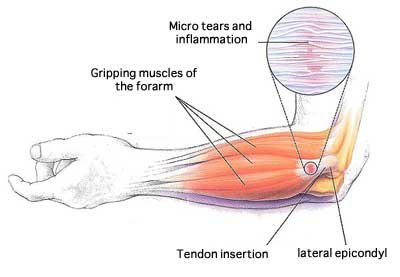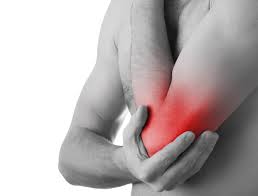As tennis season gets into full swing, we will take a look at the common condition of ‘tennis elbow’
or Lateral Epicondylalgia. Now, this loosely termed condition is actually more common in other gripping sports such as golf and hockey, but is due to the large gripping force that is required during impact with a ball.
What is it?
Lateral Epicondylalgia is essentially a degenerative change within the tendon of the common extensor origin on the outside of the elbow. As the tendon is used in this gripping position it puts high amounts of load through the tendon, and without adequate rest the tendon can quickly become sore.

How do I know if I have it?
You will most likely feel tenderness over the outer bony part of your elbow as well as pain with gripping and lifting. There will also usually be a past history of gripping sports or increased amounts of lifting. See your local Physiotherapist to confirm.
Why me?
The condition tends to affect people who are active and over 40 years of age. It is particularly common in those who use a very tight gripping position in their chosen sports. Lateral Epicondylalgia is more common in those who use a one handed backhand as that tends to place higher loads on the tendon. Studies also show that if you make contact with the ball closer to your body it can also increase your likelihood of pathology. In more recent times, studies have found a link between neck pain and Tennis Elbow, which may need to be assessed.

What treatment should I get?
The first line of treatment most people receive is Physiotherapy or see their GP. At the clinic the professional will assess the pain site, the movements affected and more than likely suggest a period of ‘active rest.’ This entails avoiding the provocative actions until the pain settles, but keeping the arm and elbow moving in pain free positions. Your physio may include elbow joint mobilisations and/or dry needling, which help to desensitise the painful area and relax the muscle respectively. Once the pain has settled the clinician will generally start you on an exercise program to improve the integrity of the tendon. These exercises should be progressed as required over the next few weeks. If the neck is contributing to your pain it should also be addressed.
What can I do about it?
The first thing is to listen to the health professional. Make sure you rest in the resting period and do the prescribed exercises when the time is right. Usually performing the isometric or eccentric exercises should bring a great deal of pain relief. Other management strategies include wearing a brace for the aggravating activities as it can take load of the tendon. Using an over-grip in racquet sports, golf and hockey can reduce pain as it decreases grip forces. Consider changing your single-handed backhand to double-hand to lessen the load on the tendon. Other important modifications included changing the tension of the strings or the type of golf club or hockey stick to decrease vibration. String tension should be lowered about 5lbs and shock dampeners are also helpful. If you are looking at a new golf or hockey stick graphite shafts tend to have less vibration and therefore send less shock into the elbow. If you are getting pain in the kitchen, it may be time to buy lighter pans or get some help with the cooking (now you have an excuse to relax!).
How long will it last?
The prognosis will largely depend on how long you have had the condition and the state of the tendon. The longer you have had the condition, the longer it will take to settle and to strengthen. Usually treatment times range from 4 weeks to 12 months. There is a large variability in prognosis due to patient compliance with exercises and resting periods. The good news is that with the right treatment tendons will improve over time and you will be able to go back to doing everything you could before!

